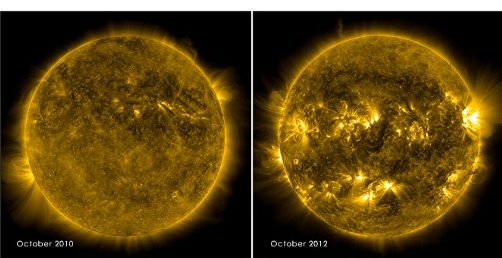In 1859, there was a solar event so extreme that witnesses reported seeing brilliant lights, electrical flashes, red glows and other aurora events, even in the South. It was the lead story on Sept. 3 of that year in the Memphis Daily, according to a copy preserved by the Library of Congress.
"On Thursday night last, about 12 o'clock, the heavens were suddenly lit up as with a half dozen moons. The cry of fire was heard on every street, and the fire bells of the city were rung, arousing our whole population. When the truth revealed itself it appears that Old Nature had only lit up its own chandelier in order, as it might be, to reveal the wickedness going on at the dead hour of night," the newspaper reported.
It was more than a light show. Telegraph systems malfunctioned, sparked and scrambled messages. The possibility that these events were connected to activity on the Sun was suggested by British astronomer, Richard Carrington, who observed intensely bright and white light from a group of sunspots.
What stirred Memphis occurred during a solar maximum, a period of increased solar activity that is marked by numerous sunspots.
If you are making a list of tech predictions for next year, as this story does, it may be a good idea to put the solar maximum on this list. The next one is expected in 2013, says NASA.
Solar maximums are natural events occurring about every 11 years, and they have caused severe disruptions to electrical systems. An event similar to the one in 1859 could be calamity.
A new U.S. government report forecasting global trends through 2030 includes a short section called "black swans," which are difficult to predict but potentially disruptive events, such as a solar storm.
"Solar geomagnetic storms could knock out satellites, the electric grid, and many sensitive electronic devices," said this report, Global Trends 2030. "The recurrence intervals of crippling solar geomagnetic storms, which are less than a century, now pose a substantial threat because of the world's dependence on electricity."

The Sun on Oct. 2010, left. On the right, an Oct. 2012 image shows a much more active Sun, which is expected to reach the "solar maximum" later next year. Image: NASA's Solar Dynamics Observatory.
The idea that solar storms can deliver serious disruption at intervals of once every hundred years is based on limited historical data. "That's as good as an estimate as anyone can give," said W. Jeffrey Hughes, director of Boston University's Center for Integrated Space Weather Modeling and a professor of astronomy.
The 1859 solar storm is now called the Carrington Event, possibly the strongest on record. But there was another, the "great storm" in May 16, 1921, which disrupted communications and power. More recently, a solar storm in 1989 was responsible for a power outage in Canada affecting 6 million. Solar storms have hurt satellites, and disrupted an FAA GPS system.
Predicting the impact of a solar maximum is difficult. Hughes likens it to hurricane season: You don't know either the severity or the types of storms that will arrive, or types of damage they may cause.
But Hughes said a solar storm has the potential of knocking out the power grid by putting DC current into large, purpose built transformers operating on AC current. These transformers cost several hundred million dollars, "and the come from places like Brazil these days." If one goes out, it may take six months for a replacement, he said.
Something else that could affect systems on a vast scale is cyberwar. It also made the government black swan list. Government officials have always been outspoken about the risks, in part, to encourage the private sector to do more. But lately, these alarms have been shrieking.
In October, U.S. Defense Secretary Leon Panetta warned that a cyberattack could "virtually paralyze the nation."
One company that studies cyber risks, Verizon, said this week that it doesn't believe that there will be all-out cyberwar next year, although it is possible. But Verizon is forecasting -- with 90% probability -- that the No. 1 security threat will be authentication-related. It says that nine of 10 intrusions will involve compromised identities.
Trend Micro, in its predictions for next year, says politically motivated attacks will become more destructive in 2013. Another concern major concern is climate change.
"Dramatic and unforeseen changes already are occurring at a faster rate than expected," reported the U.S. Global Trends report. "Most scientists are not confident of being able to predict such events."
Rising sea waters will cause many problems, something illustrated by Hurricane Sandy, which forced New York's utilities to cut power to lower Manhattan, disrupting data centers, among many other services.
What is certain not to happen is that the world will not end on Dec. 21, per the Mayan calendar. This is not quite 2013-specific, but obviously if the world does end before New Year's Day the other concerns are moot.
NASA scientists say the Mayan calendar doesn't really end on Dec. 21, but is the end of "one long-count period," followed by the start of another calendar period.



